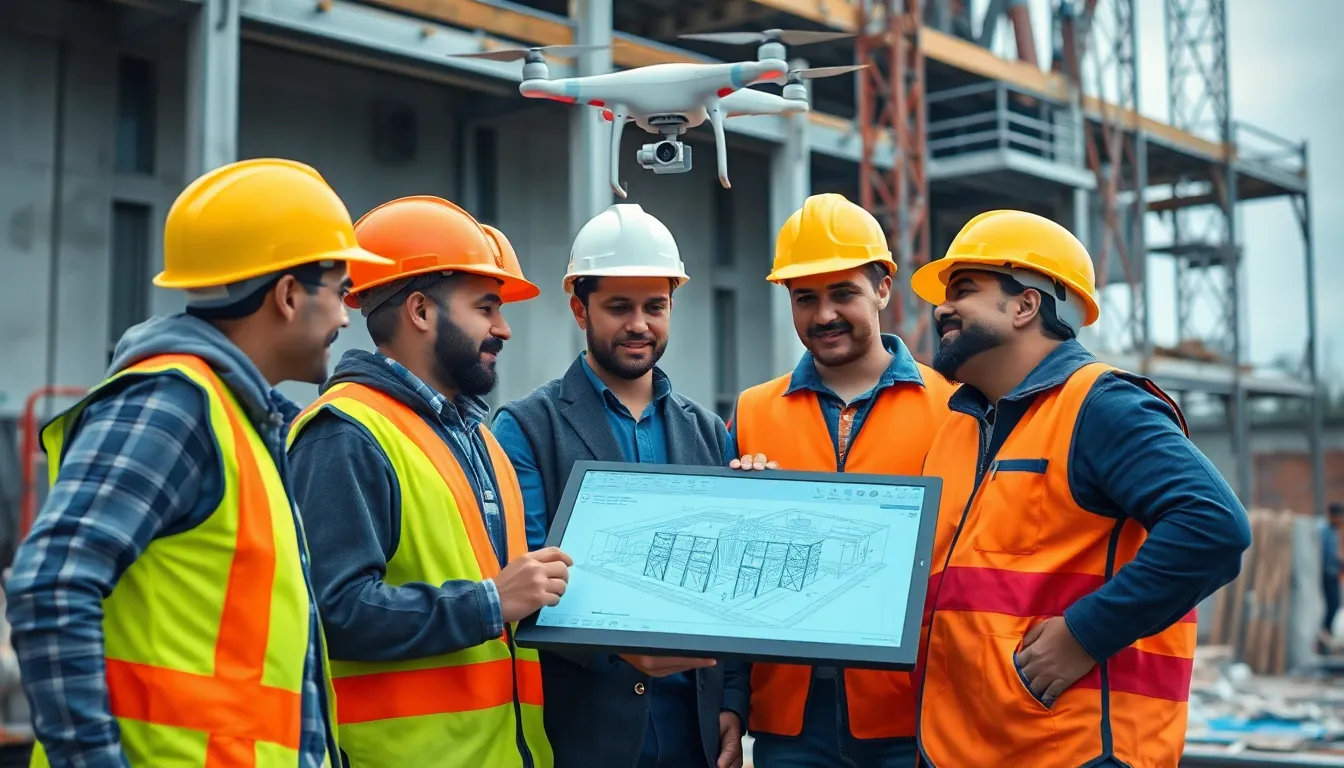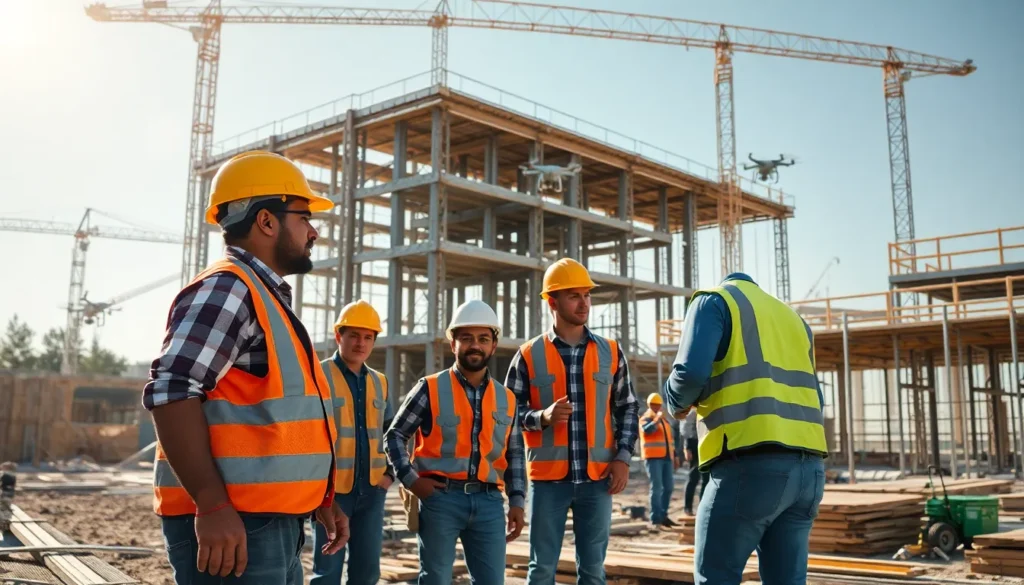Construction isn’t just about bricks and mortar anymore; it’s evolving faster than a toddler on a sugar rush. With innovations popping up like weeds in a garden, staying updated on the latest trends is crucial for anyone in the industry. From sustainable building practices to smart technology integration, the future of construction looks bright—and a little bit quirky.
Table of Contents
ToggleOverview of Construction Trends
Construction trends are continuously evolving, reflecting advancements in technology and shifting societal needs. Sustainable building practices lead the way in this evolution, with a focus on eco-friendly materials and energy efficiency. This approach reduces carbon footprints while creating healthier living environments.
Smart technology integration transforms construction methods, enhancing project management and communication. Tools like Building Information Modeling (BIM) provide real-time data, promoting collaboration among teams. Drones and 3D printing also play significant roles, increasing efficiency and reducing costs.
Prefabrication is on the rise, allowing components to be manufactured off-site for quicker assembly. This method streamlines processes and minimizes waste. Modular construction offers flexibility, enabling structures to adapt seamlessly to changing requirements.
The use of advanced materials contributes to these trends. Innovations like self-healing concrete and nanomaterials improve durability, offering extended lifespans for buildings. Such advancements ensure structures withstand environmental stresses while maintaining aesthetic appeal.
Aside from these innovations, workforce dynamics are changing. An emphasis on skilled labor training meets the demand for specialized workers in the industry. Additionally, promoting diversity and inclusion in construction leads to more innovative solutions and enhances team performance.
As trends evolve, attention toward health and safety becomes critical. Enhanced safety standards and practices protect workers and promote wellness within the construction environment. This focus reflects a broader commitment to creating sustainable, safe, and efficient spaces for future generations.
Emerging Technologies in Construction

Emerging technologies transform the construction landscape, enhancing processes and project outcomes. Innovations streamline tasks, improve safety, and optimize resource use.
Building Information Modeling (BIM)
Building Information Modeling (BIM) is a crucial tool for project visualization and collaboration. This digital representation of physical and functional characteristics fosters real-time data sharing among stakeholders. Accurate models enhance decision-making, minimize errors, and facilitate efficient construction planning. Data from BIM aids in identifying potential issues early, allowing for corrective measures before costly changes arise. Overall, BIM improves project delivery timelines and ensures resource optimization.
Drones and Site Monitoring
Drones are revolutionizing site monitoring and surveying. These unmanned aerial vehicles provide aerial imagery, enabling teams to assess project progress and identify risks from various angles. Regular drone inspections enhance safety by minimizing the need for workers to access hazardous areas. Additionally, drones collect data quickly, resulting in timely updates and efficient reporting. Integration of drone technology leads to better site management and more informed project decisions, contributing to successful project completion.
Sustainable Construction Practices
Sustainable construction practices focus on reducing environmental impacts while enhancing building efficiency. Innovations in materials and methods pave the way for a greener future in construction.
Green Building Materials
Green building materials prioritize sustainability and eco-friendliness. Bamboo, reclaimed wood, and recycled metal serve as excellent examples. These materials reduce waste and minimize the use of new resources. Additionally, low-VOC (volatile organic compounds) paints and finishes contribute to healthier indoor air quality. In many cases, using locally sourced materials can lower transportation emissions and support local economies. Increasing awareness of these options helps architects and builders make informed choices, resulting in environmentally conscious projects.
Energy Efficiency Innovations
Energy efficiency innovations transform the construction landscape by utilizing advanced technologies. Solar panels, geothermal systems, and energy-efficient windows play pivotal roles in reducing energy consumption. These technologies significantly lower utility bills while decreasing carbon footprints. Insulation materials like spray foam and structural insulated panels improve thermal performance, leading to more comfortable living environments. Smart building systems enhance energy efficiency by automating lighting and HVAC systems to adjust based on occupancy and weather conditions. Implementing these innovations encourages a more sustainable approach to modern construction.
Impact of COVID-19 on Construction Trends
COVID-19 significantly altered construction trends, pushing the industry towards more adaptive methodologies. The pandemic highlighted the need for efficient project management to meet new challenges.
Changes in Project Management
Remote collaboration tools gained prominence, enabling teams to work effectively from various locations. Virtual meetings now occur regularly, enhancing communication among stakeholders. Agile project management techniques emerged, allowing for quick adjustments to project timelines and scopes in response to shifting requirements. Emphasis on real-time data sharing became vital, with tools like Building Information Modeling facilitating seamless collaboration. Safety protocols now integrate with project schedules, ensuring worker well-being while maintaining productivity. Technological advancements also expedited decision-making processes, reducing delays and increasing efficiency.
Supply Chain Adjustments
COVID-19 disrupted supply chains, resulting in delays and shortages across materials. Construction companies adapted by strengthening relationships with local suppliers, ensuring faster access to essential resources. Emphasis on diversifying supply sources mitigated risks associated with pandemic-related disruptions. Firms now focus on inventory management, maintaining adequate stocks to prevent project standstills. Adoption of digital platforms for tracking shipments and materials improved transparency throughout the supply chain. Enhanced forecasting and planning capabilities now drive decision-making, allowing companies to navigate ongoing challenges effectively.
Future Predictions for Construction Trends
Sustainable practices will dominate future construction methods. Eco-friendly materials like bamboo and recycled metals will gain popularity due to their minimal environmental impact. Advances in energy efficiency will see innovations such as solar panels and smart building systems becoming standard in new projects.
Smart technology integration will continue evolving, with Building Information Modeling (BIM) enhancing project collaboration. Drones will be used extensively for site monitoring, improving safety and accuracy in surveying. Enhanced data sharing through these technologies will streamline communication among stakeholders.
Prefabrication and modular construction will accelerate project timelines. Expect quicker assembly as builders adapt to changing requirements with flexible design solutions. This trend reduces waste and optimizes resource use significantly.
Changing workforce dynamics will reshape labor needs. Skilled labor training programs will focus on fostering diversity and inclusion, driving innovation. Collaboration tools will support remote work, enabling teams to respond effectively to project adjustments.
Health and safety standards will become more stringent as the industry addresses the impact of COVID-19. Emphasizing safe construction environments will reflect a long-term commitment to worker well-being. Agile project management will allow teams to adjust quickly to shifting project scopes and timelines.
Supply chain resilience will be crucial moving forward. Stronger relationships with local suppliers will help mitigate risks associated with disruptions. Digital platforms will facilitate better inventory management and enhance transparency, ensuring smooth operations across the board.
The construction industry is on the brink of significant transformation. Embracing sustainable practices and smart technology is no longer optional but essential for staying competitive. As the landscape evolves emerging technologies will streamline processes and enhance safety while promoting eco-friendly solutions.
The focus on skilled labor and diversity will drive innovation and adaptability. Companies that prioritize these trends will not only improve efficiency but also create healthier and more sustainable environments. The future holds immense potential for those ready to embrace change and commit to best practices in construction.





